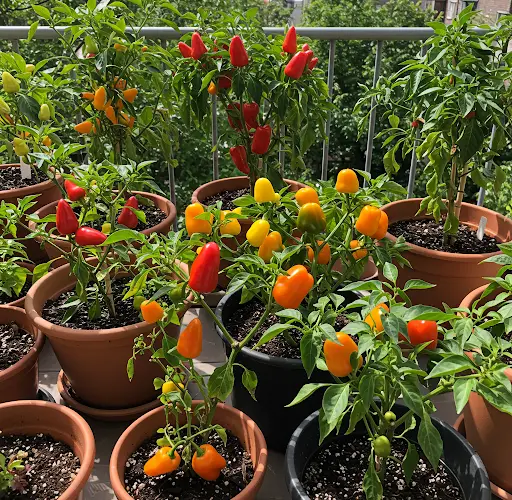Peppers are a popular and rewarding crop for container gardening. Whether you’re growing sweet bell peppers or spicy chili varieties, they can thrive in pots with the right care and conditions. Starting peppers from seed gives you more variety and control over the growing process, and it’s easier than many gardeners think. This step-by-step guide will walk you through everything you need to know to grow peppers in containers from seed—perfect for balconies, patios, or small garden spaces.
Why Grow Peppers in Containers?
Container gardening offers flexibility and convenience, especially for those with limited space. Peppers adapt well to container life as long as they get enough sunlight, warmth, and consistent watering. Containers can also help control pests and diseases, and allow you to move plants to warmer spots if needed.
Choosing the Right Pepper Variety
There are many pepper varieties suited for container growing. When selecting seeds, consider compact or dwarf types that don’t need a huge root system. However, even larger varieties can do well if given a big enough pot and proper support.
Some great varieties for containers include:
-
‘Mini Bell’ – A compact, sweet pepper that matures quickly.
-
‘Jalapeño’ – A medium-heat chili that thrives in pots.
-
‘Cayenne’ – Productive and manageable with support.
-
‘Hungarian Wax’ – Tolerates cool temperatures and grows well in containers.
Starting Peppers from Seed
Peppers need a warm and consistent environment to germinate, so start seeds indoors 8 to 10 weeks before the last expected frost in your area. Here’s how:
-
Choose seed trays or small pots: Use clean containers with drainage holes. Fill them with seed-starting mix—not regular potting soil—to encourage healthy root development.
-
Plant the seeds: Sow each seed about 1/4 inch deep. Water gently to settle the mix.
-
Provide warmth: Pepper seeds germinate best at 75°F to 85°F (24°C to 29°C). Use a heat mat or place trays in a warm, sunny location.
-
Keep moist but not soggy: Cover with a humidity dome or plastic wrap until seedlings emerge, usually within 7 to 14 days.
Once the seedlings appear, remove any covers and move the trays to a bright location. A sunny windowsill or grow light setup is ideal. Rotate the containers regularly to prevent leggy growth.
Transplanting into Containers
When seedlings have at least two sets of true leaves and outdoor temperatures are consistently above 60°F (16°C), they’re ready to move into their final containers. First, harden them off by gradually exposing them to outdoor conditions over 5 to 7 days.
Container Requirements:
-
Size: Choose containers at least 12 to 16 inches deep and wide per plant.
-
Material: Plastic, clay, fabric, or ceramic pots all work—just ensure they have drainage holes.
-
Soil: Use high-quality potting mix with added compost or organic matter for nutrients and aeration.
Planting Steps:
-
Fill the container with soil, leaving about 1 inch from the top.
-
Make a hole and place the seedling, burying the stem slightly deeper than it was in the tray.
-
Water thoroughly after transplanting.
-
Add a stake or cage to support the plant as it grows.
Sunlight and Temperature
Peppers love heat and light. Place containers where they’ll receive at least 6 to 8 hours of direct sunlight per day. If growing indoors, supplement with grow lights to ensure they get enough light.
Avoid placing containers in windy spots or areas that cool down quickly at night. Peppers prefer daytime temperatures around 70°F to 85°F (21°C to 29°C) and nighttime temperatures above 60°F (16°C).
Watering and Fertilizing
Keep the soil evenly moist but not soggy. Peppers in containers dry out faster than those in the ground, so check soil moisture regularly. Water when the top inch of soil feels dry.
For best results:
-
Use a balanced fertilizer every two weeks during the growing season, or slow-release pellets mixed into the soil.
-
Once plants start flowering, switch to a fertilizer higher in potassium and phosphorus to boost fruiting.
Pruning and Pollination
Pinching off the first flowers encourages the plant to grow bushier and produce more fruit. If growing indoors or in a space with limited pollinators, gently shake the plant or hand-pollinate using a soft brush.
Common Issues to Watch For
-
Blossom drop: Often caused by extreme temperatures or inconsistent watering.
-
Yellowing leaves: May indicate overwatering or nutrient deficiencies.
-
Pests: Aphids and spider mites can be treated with neem oil or insecticidal soap.
Harvesting Peppers
Harvest time depends on the variety, but most peppers are ready 60 to 90 days after transplanting. You can pick them when green or wait until they fully ripen to red, yellow, or orange for more flavor and sweetness. Use scissors or garden shears to avoid damaging the plant.
With the right care, growing peppers in containers from seed is a simple and satisfying process. The reward is fresh, flavorful peppers right at your doorstep, and the satisfaction of nurturing them from seed to harvest.



